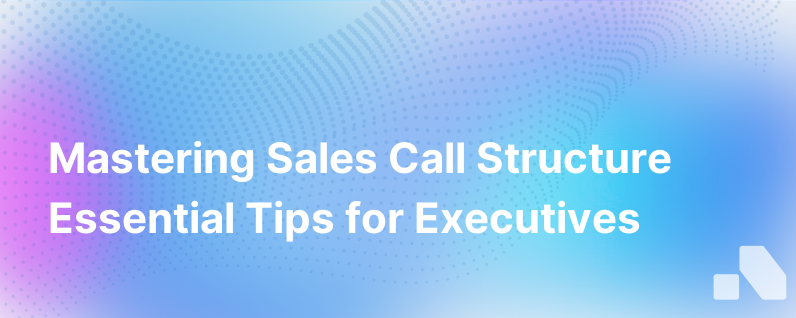Sales Call Structure Tips
Published on August 25, 2023 by David Zhang
In the high-velocity world of sales, the structure of your sales calls can make the difference between success and a fruitless interaction. It’s a challenge every salesperson faces - how can you consistently guide a conversation so that it uncovers customer needs, builds rapport, and ultimately, closes deals? A meticulously designed sales call structure can be your roadmap to achieving these goals.
Here we share some highly effective strategies for structuring your sales calls that could help turn a prospect into a loyal customer.
Start With Pre-Call Research and Planning
Before you even dial the number or log into that video call, you want to come equipped with knowledge about your prospect. Detailed pre-call planning involves understanding who you're talking to, their company, the challenges they might be facing, and potential solutions you can offer. It's the reconnaissance stage, and it's critical for grounding your call strategy.
Take advantage of tools like LinkedIn, company databases, or dedicated sales intelligence platforms like Aomni to gather this information effectively and efficiently.
Opening the Call
The Warm-Up
Begin with a personal touch. People want to do business with humans, not scripts. A friendly greeting and a minute or two of warm-up conversation can help put your prospect at ease. Just remember to keep it professional and not too personal.
"Good morning, [Name]! I hope the day’s treating you well?"
Purpose Statement
Once pleasantries are exchanged, it's vital to communicate the intent of your call within the first few minutes. This gives your prospect a clear understanding of why they should invest their time in speaking with you.
"The reason for my call is to explore how we can help [company] streamline your sales process with actionable insights."
Discovery
Crafting Questions
The discovery phase is your opportunity to learn about your prospect. This involves asking open-ended questions designed to draw out pain points, challenges, goals, and their current environment.
"Can you walk me through your current sales process and highlight any areas you find challenging or would like to improve?"
Active Listening
Listening is more than just waiting for your turn to speak. It involves processing what the prospect is saying, understanding their concerns, and reacting empathetically.
Taking Notes
Good notes help you remember the points made during the call and enable you to tailor your subsequent sales pitches to the unique needs and pain points of the prospect. Most importantly, they serve as a record to refer back to for future interactions.
Presenting Solutions
Align Solutions with Pain Points
Now’s your chance to shine. Refer back to the issues and needs identified in the discovery phase and illustrate how your product or service addresses them.
"You mentioned that you’re looking for ways to increase your team's efficiency. Our solution, Aomni, enables your team to access personalized sales content that cuts down the preparation time significantly."
How to Handle Objections
Expect and embrace objections; they’re a natural part of the sales process. Address them head-on, providing clear and empathetic responses that overcome your prospect's hesitations or concerns.
Demonstration
If possible, show rather than tell. A demo during the call can be a powerful tool to show the practical benefits of your solution. Consider pre-recording a quick demo that is easily shareable if a live demo isn’t feasible.
Building Value
Case Studies and Testimonials
Bring in real-world success stories and testimonials to back your claims and show your prospect that others with similar challenges have found success with your solution.
Quantify Benefits
Make the abstract concrete. Show potential ROI, time savings, efficiency gains, or other quantifiable benefits they can expect.
Advancing the Sale
Trial Closes
Gauge your prospect’s interest and get commitment by proposing hypothetical scenarios.
"If we could demonstrate a 20% increase in your sales team’s outreach, would that compel you to implement our tool?"
Setting Next Steps
Be clear about what the next steps look like and who is responsible for what, whether it’s a follow-up call, a demo, or sending over a proposal.
"Would Wednesday work for a follow-up call? I’ll send over a calendar invite."
Closing the Call
Summarize and Confirm Understanding
Recap the main points discussed, the prospect's needs, how your solution aligns with their pain points, and the next steps. Confirm mutual understanding to ensure you’re on the same page.
Closing Appreciation
Regardless of the outcome, end the call on a positive note, thanking the prospect for their time and providing reassurance about the following stages.
"Thank you for the insightful conversation today, [Name]. Looking forward to our next steps."
Post-Call: Reflect and Document
After the call, take the time to reflect on what went well and areas for improvement. Document your notes thoroughly in your CRM, including action items and follow-up dates.
Key Takeaways
Here’s a quick rundown of how to structure your sales calls for success:
- Start with robust pre-call research.
- Open the call with a personal touch and a clear purpose.
- Conduct a discovery session to understand your prospect's challenges.
- Present customized solutions that address specific pain points.
- Build value by quantifying benefits and sharing testimonials.
- Use trial closes to measure interest and set concrete next steps.
- Close the call with a positive reinforcement and a thank-you message.
Remember, mastery of sales calls is a mix of good structure and the ability to adapt. The more you practice, the more natural your calls will feel, and the more success you are likely to enjoy.
Sales call success is not just about structure; it's about the value you can deliver succinctly and empathetically. With proper planning and practice, your calls can be powerful tools for building relationships and closing deals.
A tool like Aomni can greatly bolster your sales call structure by providing real-time account research and personalized sales content at your fingertips, ensuring that you enter each call equipped with everything you need to engage your prospects and drive the conversation towards a successful close.